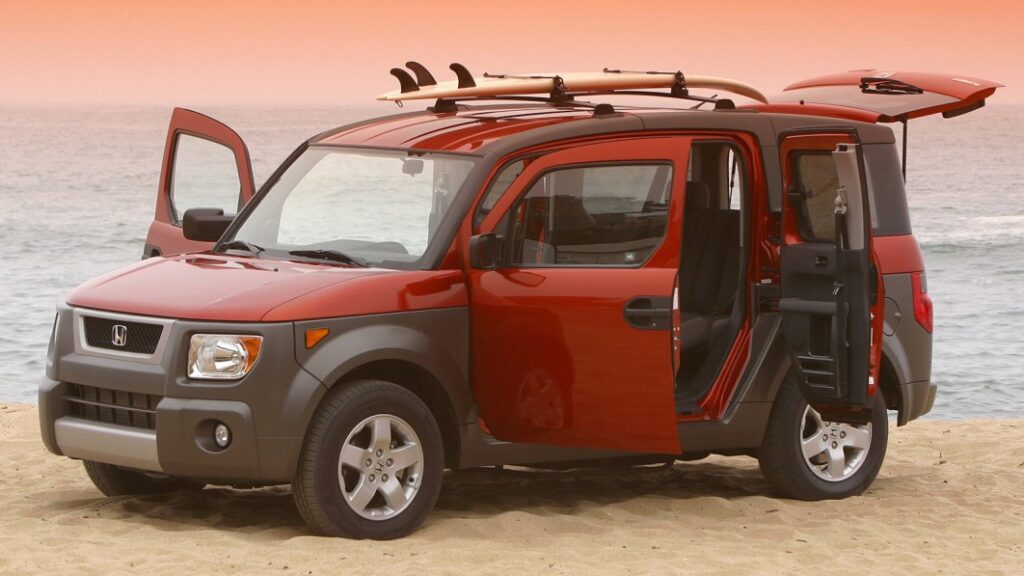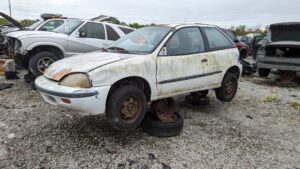Future Classic: 2003-2011 Honda Element

You know, if Honda introduced the Element right now, it might actually be a hit. Think about it: Light-duty SUVs of all shapes and sizes are hugely popular. Add in even the tiniest bit of off-road cred and you’ve got a recipe for success.
Based on the 2001 Honda Model X Concept – no, not that Model X – the Element was a hit when it first arrived on the scene in late 2002. Honda surpassed its original sales projections, but deliveries dwindled as the years passed. Ultimately, Honda discontinued the Element in 2011. As far as we’re concerned, the Element was ahead of its time.
Why is the Honda Element a future classic?
With its boxy shape and exaggerated wheel arch cladding, the Element wore its rugged heart on its sleeve. That fun-and-functional design was backed up by an interior that was spacious and super easy to clean. The seats were trimmed in stain-resistant fabric, the floor had a urethane coating so you could hose out any mud and the back bench was reclinable, collapsable and removable. You could totally sleep back there on a camping trip.
Of course, the Element is arguably best known for its unique body style, which consisted of two large front doors and a pair of rear-hinged suicide doors. Initially, the front seatbelts were attached to the rear doors, which made it somewhat tough to get in and out of the back seats, but Honda fixed this problem as part of the Element’s 2007 model year refresh.
Throughout its entire existence, Honda only offered the Element with a 2.4-liter naturally aspirated I4 engine. Originally available with 160 horsepower, the 2.4-liter engine could be paired with four-speed automatic or five-speed manual transmissions, as well as front- or all-wheel drive. The 2007 update brought the addition of 6 hp, for 166 total, and the four-speed automatic was replaced with a more modern five-speed unit. By the end of its life, only the all-wheel-drive EX trim could be had with the manual gearbox.
What is the ideal example of the Honda Element?
When deciding which Element to buy, it really comes down to whether or not you want all-wheel drive. If that’s a must – and given the SUV’s ethos, we can’t blame you – we definitely recommend going for one of the examples with the five-speed manual, since it made the Element more entertaining to drive, and allowed you to really eke out the small engine’s available power.

If the extensive plastic exterior cladding isn’t your thing, look for an Element EX-P (above right). Introduced in 2005, the EX-P offered body-colored exterior panels for a $500 upcharge. Honda also sold a number of Dog Friendly Elements, so if you’re sick of shopping for Subarus, this might be a good one to consider.
Of course, there’s also the extra-cool Element SC (above left), though this one pretty much throws any off-road capability out the window. Available exclusively with front-wheel-drive, the SC was offered from 2007 to 2010. It had a different front bumper and grille, lowered suspension, 18-inch wheels, unique seat fabric and a carpeted floor. Find one in Root Beer Metallic with the five-speed manual transmission and you’re set.




Our used vehicle listings can be helpful to find a good deal near you. Narrow the offerings down by a radius around your ZIP code, and pay attention to the deal rating on each listing to see how a vehicle compares with others in a similar area.
Are there any good alternatives to the Honda Element?
The Element split the difference between many different types of vehicles; you can’t really compare it to a proper off-roader like the Jeep Wrangler, and the two-door Ford Explorer Sport was larger and rode on a proper truck chassis. Instead, the Element tended to get lumped in with other upright hatchbacks – things like the Chrysler PT Cruiser, Chevrolet HHR, Nissan Cube and Scion xB.
Would modern interpretations of any of these vehicles play in today’s car market? That’s hard to say. But the Element sure seems like it’d have the best chance. For now, though, you’re better off looking for a well-kept used example.






